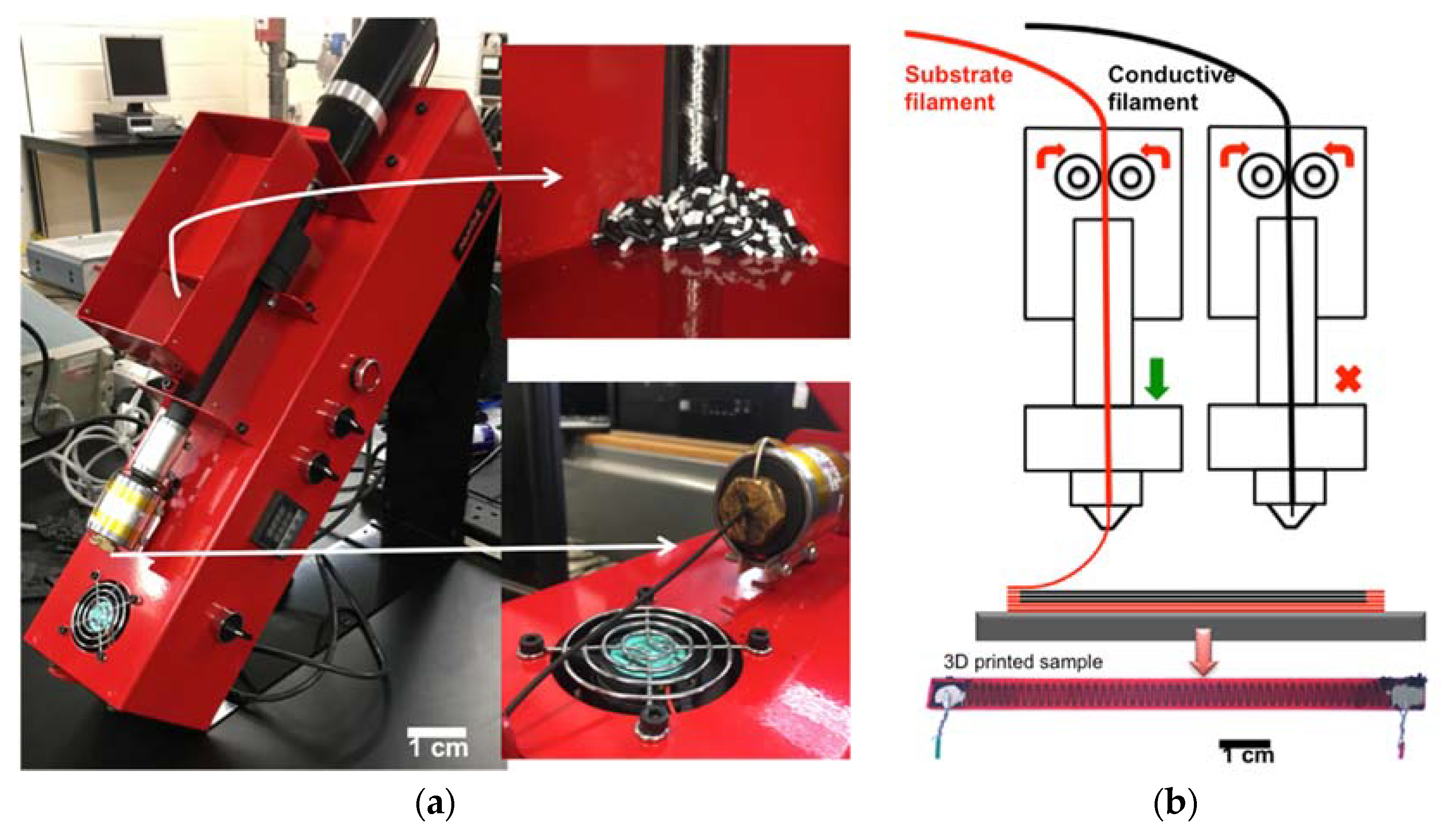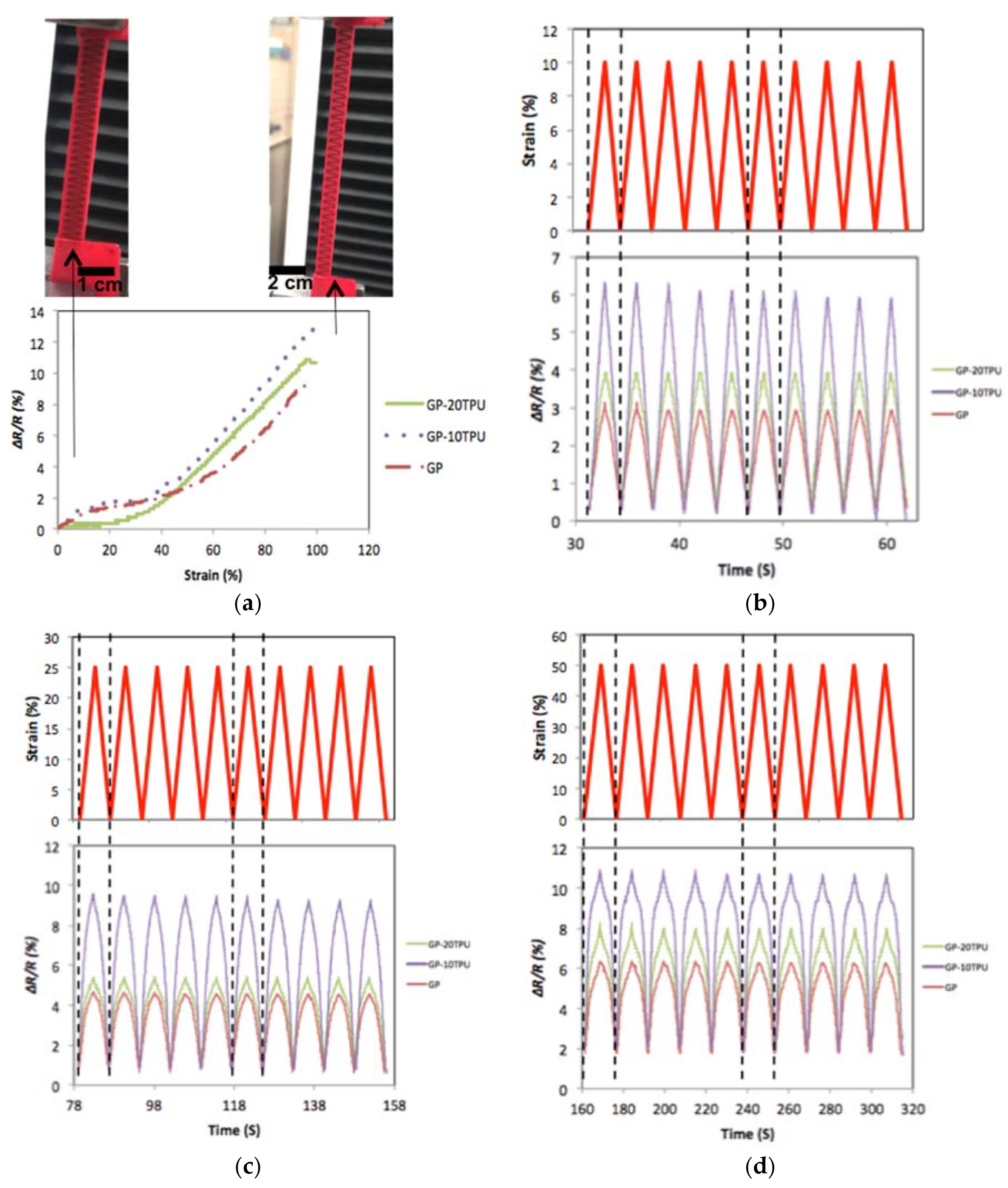3D Printing of Highly Stretchable and Sensitive Strain Sensors Using Graphene Based Composites †
Abstract
:1. Introduction
2. Materials and Methods
2.1. Materials
2.2. Composites Preparation
3. Results
3.1. Electromechanical Properties
3.2. Cyclic Strain Behaviour
4. Conclusions
References
- Berman, B. 3-D printing: The new industrial revolution. Bus. Horiz. 2012, 55, 155–162. [Google Scholar] [CrossRef]
- MacDonald, E.; Salas, R.; Espalin, D.; Perez, M.; Aguilera, E.; Muse, D.; Wicker, R.B. 3D printing for the rapid prototyping of structural electronics. IEEE Access 2014, 2, 234–242. [Google Scholar] [CrossRef]
- Zhang, D.; Chi, B.; Li, B.; Gao, Z.; Du, Y.; Guo, J.; Wei, J. Fabrication of highly conductive graphene flexible circuits by 3D printing. Synth. Met. 2016, 217, 79–86. [Google Scholar] [CrossRef]
- Jesse, G.; Travis, F. 3D Printed Strain Gauge Geometry and Orientation for Embedded Sensing. In Proceedings of the 58th AIAA/ASCE/AHS/ASC Structures, Structural Dynamics, and Materials Conference, Grapevine, TX, USA, 9–13 January 2017; (AIAA 2017-0350); AIAA SciTech Forum: Reston, VA, USA, 2017. [Google Scholar]
- Christ, J.F.; Aliheidari, N.; Ameli, A.; Pötschke, P. 3D printed highly elastic strain sensors of multiwalled carbon nanotube/thermoplastic polyurethane nanocomposites. Mater. Des. 2017, 131, 394–401. [Google Scholar] [CrossRef]
- Lozano-Pérez, C.; Cauich-Rodríguez, J.V.; Avilés, F. Influence of rigid segment and carbon nanotube concentration on the cyclic piezoresistive and hysteretic behavior of multiwall carbon nanotube/segmented polyurethane composites. Compos. Sci. Technol. 2016, 128, 25–32. [Google Scholar] [CrossRef]
- Balakrisnan, B.; Nacev, A.; Burke, J.M.; Dasgupta, A.; Smela, E. Design of compliant meanders for applications in MEMS, actuators, and flexible electronics. Smart Mater. Struct. 2012, 21, 075033. [Google Scholar] [CrossRef]
- Yazdani, H.; Hatami, K.; Khorsravi, E.; Harper, K.; Grady, B.P. Strain-Sensitive conductivity of carbon black-filled PVC composites subjected to cyclic loading. Carbon 2014, 79, 393–405. [Google Scholar] [CrossRef]


| Parameter | Value |
|---|---|
| Print Temperature (°C) | 230 |
| Platform Temperature (°C) | 60 |
| Print Nozzle Diameter (mm) | 0.4 |
| Layer Height (mm) | 0.2 |
| Print Infill (%) | 100 |
| Print Speed (mm/s) | 15 |
Publisher’s Note: MDPI stays neutral with regard to jurisdictional claims in published maps and institutional affiliations. |
© 2018 by the authors. Licensee MDPI, Basel, Switzerland. This article is an open access article distributed under the terms and conditions of the Creative Commons Attribution (CC BY) license (https://creativecommons.org/licenses/by/4.0/).
Share and Cite
Alsharari, M.; Chen, B.; Shu, W. 3D Printing of Highly Stretchable and Sensitive Strain Sensors Using Graphene Based Composites. Proceedings 2018, 2, 792. https://doi.org/10.3390/proceedings2130792
Alsharari M, Chen B, Shu W. 3D Printing of Highly Stretchable and Sensitive Strain Sensors Using Graphene Based Composites. Proceedings. 2018; 2(13):792. https://doi.org/10.3390/proceedings2130792
Chicago/Turabian StyleAlsharari, Meshari, Baixin Chen, and Wenmiao Shu. 2018. "3D Printing of Highly Stretchable and Sensitive Strain Sensors Using Graphene Based Composites" Proceedings 2, no. 13: 792. https://doi.org/10.3390/proceedings2130792
APA StyleAlsharari, M., Chen, B., & Shu, W. (2018). 3D Printing of Highly Stretchable and Sensitive Strain Sensors Using Graphene Based Composites. Proceedings, 2(13), 792. https://doi.org/10.3390/proceedings2130792




